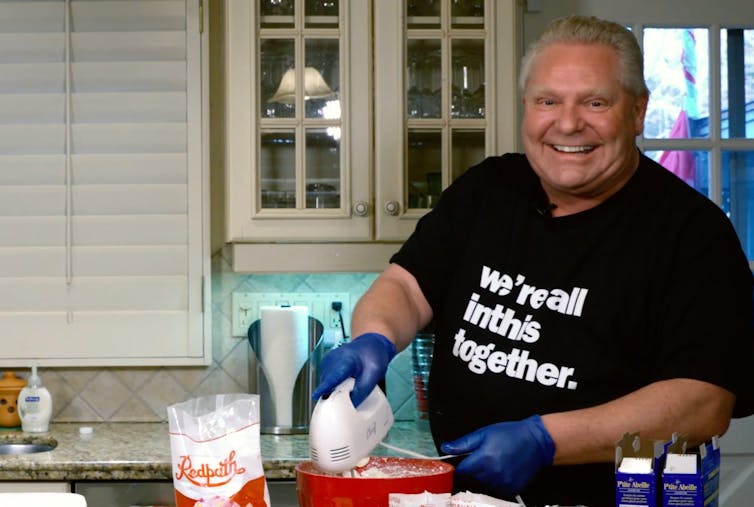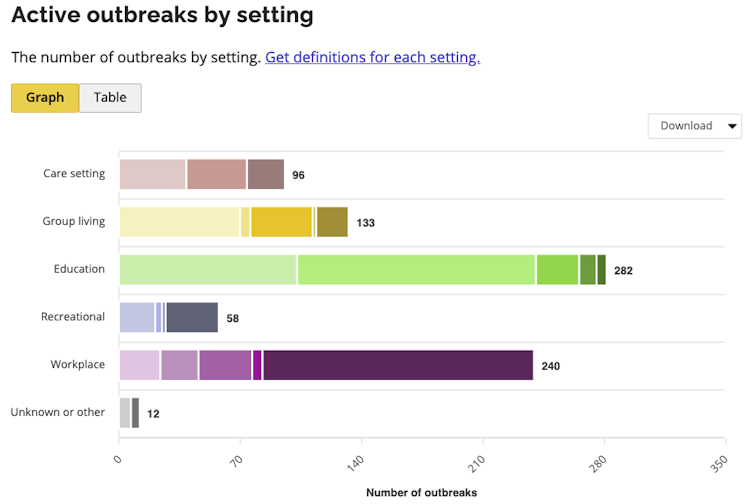
Yvonne Su, York University, Canada
One year ago, politicians across Canada told us “we’re all in this together.” Ontario Premier Doug Ford delivered the message during a video as he made cherry cheesecake. And Canadians bought into it.
They organized online to get groceries to seniors, to #SupportLocal and to clap for carers — examples of the made-in-Canada “caremongering” movement were talked about globally.
Now, after a year of repeated lockdowns and a confusing vaccine rollout, people across the country are online and organizing anti-lockdown marches, anti-curfew protests and riots and disseminating anti-vaccine conspiracies. Some Canadians are angry and defiant.
Short-lived solidarity
While some thought the pandemic would level the playing field and bring communities together, scholars who study community recovery after crises were aware that solidarity would be short-lived. To make matters worse, scholars have observed that social inequality and social divisions often re-emerge after a crisis and can sometimes become even stronger.
Read more: How a time of panic buying could yet bring us together
In Ontario, the inequality that lower-income and racialized communities face has worsened amid COVID-19.
As the third wave hits hot-spot communities, people affected are less protected and prioritized now, and hit harder than when the pandemic started. Many are blaming the Ontario government’s poor public health policies for what doctors are calling a preventable “humanitarian catastrophe.”
What we are witnessing in Ontario is politically produced precarity. Politically produced precarity is when political discourse and public policies create an environment that makes people experience precarity (or uncertainty). This can be seen through essential workplaces being allowed to stay open during Ontario’s state of emergency, but neglecting essential workers when it comes to prioritizing them for vaccinations. These workers are made precarious by the policies in place, not due to the lack of vaccines.
Data on the Ontario government’s website shows that workplaces account for 29 per cent of all COVID-19 outbreaks. This is only second to education, which accounts for 34 per cent of outbreaks.
While the Ontario government has followed the evidence in this third wave and shut down schools, workplaces that include factories, food-processing plants and farms are still open and essential workers are still not being prioritized for vaccinations.

Their work is essential, but not their lives
Dr. Shail Rawal, an internal medicine physician, tweeted on April 16, capturing the current situation in Ontario well when she said: “They looked us in the eye and said your labour is essential, but your lives are not.”
In addition to not being prioritized for vaccinations, despite having no option but to go into work, essential workers still don’t have paid sick leave. Since the beginning of the pandemic, doctors and local medical officers of health across Ontario have called for paid sick leave. This call has only grown stronger during the third wave.
Ford continues to push back, saying there is already a federal program in place. But advocates say the federal COVID-19 sick leave benefit has restrictions that make it inaccessible to lower-income, precarious and migrant workers.
A recent poll found the vast majority of Ontario residents are in favour of paid sick days. Yet, despite so much support, essential workers are still forced to go to work even if they feel sick, risking the spread of COVID-19.
Torontonian Andrew Do shared on Twitter and in the media how both his parents got COVID-19 days before their vaccine appointments. Do’s father works in a factory where he believes he got infected, and his parents live at Jane and Finch, a lower-income neighbourhood located in Toronto’s northwest.
As Do explains, he thinks his parents’ vulnerability increased during the pandemic because of how the neighbourhood is treated by governments and the health-care system.
Elena Fiddian-Qasmiyeh, a researcher who studies politically produced precarity, explains how we need to understand the vulnerabilities that people are facing and their responses. She says we can do this by considering how local experiences and responses are framed by political systems and the structural inequalities and processes of marginalization and exclusion that have gotten us here.
It is these structures and policies that leave essential workers exposed to COVID-19 and at risk of dying due to lack of vaccine access.
The wealthier the neighbourhood, the more vaccines
The inequality in vaccine access is summed up by a recent article in the Toronto Star: “A tale of two neighbourhoods: Jane and Finch with the lowest vaccination rate, Moore Park with the highest.” The story highlights how one of the poorest neighbourhoods in Toronto has the lowest vaccination rate, and one of the richest neighbourhoods has the highest.
An analysis from the Institute for Clinical Evaluative Sciences showed that COVID-19 is disproportionately affecting Toronto neighbourhoods with the most essential workers and lowest income levels. Similarly, pharmacies that administer vaccines are primarily located in Toronto’s most affluent neighbourhoods.
In addition, an investigation into how hot-spot postal codes were selected by the Ford government has revealed that vaccine rollout may have been driven by partisan considerations. Five of the included zones — all represented by Progressive Conservative MPPs — had infection rates that were below the provincial average while seven excluded zones had higher-than-average infection rates but are represented by opposition politicians.
This news, combined with stories of young front-line workers begging pharmacists for vaccines while vaccines sit in freezers at risk of expiration, have enraged many Ontarians. Some have started to count the days until the next provincial election while others have called for Ford’s resignation.
Ending politically produced precarity?
Ending these injustices, and politically produced precarity, may be difficult without increased representation in politics of people from lower-income and racialized communities. As one Twitter user pointed out: “It is impossible to govern effectively if you don’t think or care about people who don’t live exactly as you do.”
The recent Ontario announcement that included giving more power to police to enforce stay-at-home orders, and the subsequent public backlash, highlights why representation matters. It showed how out of touch the government of Ontario is because carding has long been condemned due to its connections to racial profiling.
It was a glaring misstep to fail to realize more enforcement was going to greatly impact racialized and low-income communities who are already hardest hit by COVID-19 and the least likely to be vaccinated. Despite scaling back police powers so only those who are suspect of participating in gatherings will be stopped, too much power still remains in the hands of people who shouldn’t have it. And the rules are changing so rapidly that essential workers likely can’t keep up and will live under a cloud of fear every time they leave the house.
The third wave has been confusing, and as we look towards our post-pandemic recovery, we will not be able to happy-wash the pandemic with caremongering stories.
Instead we must never forget how inequality has worsened, and recovery has been slowed or made worse by policy, so we can hold governments accountable when the next elections come around.
COVID-19 has shown us that we are not all in this together, and it has also shown us that as communities, we have the power to come together and advocate for the most vulnerable when politicians are actively putting them in harm’s way.![]()
Yvonne Su, Assistant Professor in Interdisciplinary Refugee and Diaspora Studies, York University, Canada
This article is republished from The Conversation under a Creative Commons license. Read the original article.

